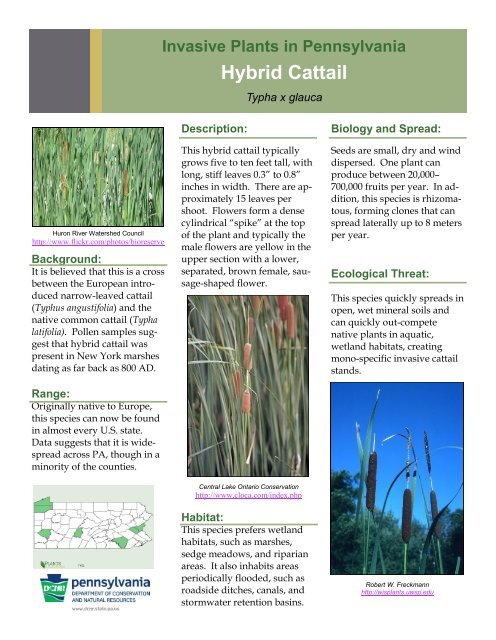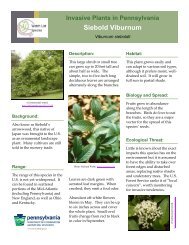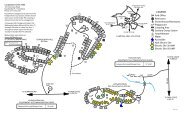Hybrid Cattail - Pennsylvania Department of Conservation and ...
Hybrid Cattail - Pennsylvania Department of Conservation and ...
Hybrid Cattail - Pennsylvania Department of Conservation and ...
Create successful ePaper yourself
Turn your PDF publications into a flip-book with our unique Google optimized e-Paper software.
Invasive Plants in <strong>Pennsylvania</strong><br />
<strong>Hybrid</strong> <strong>Cattail</strong><br />
Typha x glauca<br />
Huron River Watershed Council<br />
http://www.flickr.com/photos/bioreserve<br />
Background:<br />
It is believed that this is a cross<br />
between the European introduced<br />
narrow-leaved cattail<br />
(Typhus angustifolia) <strong>and</strong> the<br />
native common cattail (Typha<br />
latifolia). Pollen samples suggest<br />
that hybrid cattail was<br />
present in New York marshes<br />
dating as far back as 800 AD.<br />
Range:<br />
Originally native to Europe,<br />
this species can now be found<br />
in almost every U.S. state.<br />
Data suggests that it is widespread<br />
across PA, though in a<br />
minority <strong>of</strong> the counties.<br />
Description:<br />
This hybrid cattail typically<br />
grows five to ten feet tall, with<br />
long, stiff leaves 0.3” to 0.8”<br />
inches in width. There are approximately<br />
15 leaves per<br />
shoot. Flowers form a dense<br />
cylindrical “spike” at the top<br />
<strong>of</strong> the plant <strong>and</strong> typically the<br />
male flowers are yellow in the<br />
upper section with a lower,<br />
separated, brown female, sausage-shaped<br />
flower.<br />
Biology <strong>and</strong> Spread:<br />
Seeds are small, dry <strong>and</strong> wind<br />
dispersed. One plant can<br />
produce between 20,000–<br />
700,000 fruits per year. In addition,<br />
this species is rhizomatous,<br />
forming clones that can<br />
spread laterally up to 8 meters<br />
per year.<br />
Ecological Threat:<br />
This species quickly spreads in<br />
open, wet mineral soils <strong>and</strong><br />
can quickly out-compete<br />
native plants in aquatic,<br />
wetl<strong>and</strong> habitats, creating<br />
mono-specific invasive cattail<br />
st<strong>and</strong>s.<br />
Central Lake Ontario <strong>Conservation</strong><br />
http://www.cloca.com/index.php<br />
Habitat:<br />
This species prefers wetl<strong>and</strong><br />
habitats, such as marshes,<br />
sedge meadows, <strong>and</strong> riparian<br />
areas. It also inhabits areas<br />
periodically flooded, such as<br />
roadside ditches, canals, <strong>and</strong><br />
stormwater retention basins.<br />
Robert W. Freckmann<br />
http://wisplants.uwsp.edu
How to Control this Species:<br />
Native Alternatives:<br />
Depending on the<br />
characteristics <strong>of</strong> each site, a<br />
variety <strong>of</strong> control measures<br />
can be used to limit the<br />
spread <strong>of</strong> hybrid cattails. Often<br />
if water levels can be manipulated<br />
in conjunction with<br />
cutting or mechanical removal,<br />
hybrid cattail can be<br />
controlled.<br />
Treatment with chemical<br />
control agents is possible;<br />
however extreme care must<br />
be taken in applying<br />
herbicides to wetl<strong>and</strong><br />
habitats. Be sure to use<br />
herbicides that readily break<br />
down in water <strong>and</strong> are not<br />
harmful to other aquatic<br />
plants or animals.<br />
Look-A-Likes:<br />
This species looks very similar<br />
to the native common cattail<br />
(Typha latifolia), but the<br />
common cattail has wider<br />
leaves (1/2 to 1 inch wide) <strong>and</strong><br />
no gap exists on the stem<br />
between male <strong>and</strong> female<br />
flowers. It also closely resembles<br />
the narrow-leaved cattail<br />
(scientific name), it’s other parent<br />
species. Narrow-leaved<br />
cattail is typically shorter atthree<br />
to five feet in height,<br />
with long, stiff leaves (1/4 to<br />
1/2 inch in width).<br />
Fire has been used to control<br />
hybrid cattail, but rhizomes<br />
must be burned or resprouting<br />
following fire will<br />
occur.<br />
More information can be<br />
found at:<br />
Exotic Plant Pest Tutorial:<br />
http://www.dcnr.state.pa.<br />
us/forestry/invasivetutorial/<br />
cattail_M_C.htm<br />
USDA Forest Service Fire<br />
Effects Information System:<br />
http://www.fs.fed.us/<br />
database/feis/plants/<br />
graminoid/typang/all.html<br />
References:<br />
Invasive Species Compendium:<br />
http://www.cabi.org/isc/default.aspx?site=144&page=4066<br />
USDA PLANTS Database:<br />
http://plants.usda.gov/java/pr<strong>of</strong>ile?symbol=TYAN<br />
Wisconsin <strong>Department</strong> <strong>of</strong> Natural Resources:<br />
http://dnr.wi.gov/invasives/fact/narrow_cattail.htm<br />
Rhoads, A.F. & Block, T.A. 2007. The Plants <strong>of</strong> <strong>Pennsylvania</strong>: An<br />
Illustrated Manual. 2nd ed. University <strong>of</strong> <strong>Pennsylvania</strong> Press:<br />
Philadelphia, PA.<br />
For More Information:<br />
The best native alternative for<br />
hybrid cattail is the native<br />
common cattail (Typha latifolia).<br />
Graves Lovell<br />
www.forestryimages.com<br />
To learn more about invasive species in <strong>Pennsylvania</strong>, check out<br />
the following site:<br />
DCNR Invasive Species Site: http://www.dcnr.state.pa.us/<br />
conservationscience/invasivespecies/index.htm
















